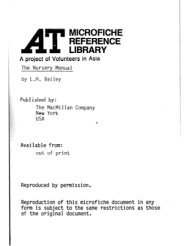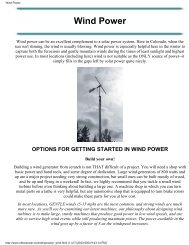- Page 1: * ., j’ AT .? ,_ L’( .; p MICRO
- Page 5 and 6: - r ooks, Palo Alto, California
- Page 7 and 8: Publisher’s Acknowledgments The p
- Page 9 and 10: TABLE OF Author% Note 6 ----W CONTE
- Page 11 and 12: FOR’EWORD 0
- Page 13 and 14: Introduction 100-kW to 300-kW unrts
- Page 15 and 16: .-- ;, * _ 2. .,-. ‘. / r -r ‘A
- Page 17 and 18: Energy and power are derived from t
- Page 19 and 20: An American Farm Windmill and water
- Page 21 and 22: Y . 2 &Wind Power ’ 1 Systemi Som
- Page 23 and 24: P. Installation of a sailwing ‘ro
- Page 25 and 26: Sucker rod and water pump used with
- Page 27 and 28: . . . 30 k I .’ The Wind Power Bo
- Page 29: 32 The Wind Power Book Fiberglass-b
- Page 33 and 34: A close-up view of Cullen’s !S?-w
- Page 35 and 36: * W indspeed+ ; Powers curves for t
- Page 37 and 38: s i; , ! . I 6 40 _ _I_- , The Wind
- Page 39 and 40: . -... .- * Above: Close-up viei of
- Page 41 and 42: \ -- Wind Energy FksoWxs . Understa
- Page 43 and 44: _ . Surface winds Horse Jabtudes y3
- Page 45 and 46: The density of any s+stance is a me
- Page 47 and 48: , j$. ’ 8 c _- - ;. ‘- $3. 0 -.
- Page 49 and 50: ‘\m ‘. ent onthsb; anuary nd Ma
- Page 51 and 52: With a year or more of windspeed da
- Page 53 and 54: “-. ” 56 The Wind Power Book
- Page 55 and 56: 58 The Wind Power Book amplitude 0
- Page 57 and 58: A pressure-plate anemometer: Wind p
- Page 59 and 60: c , 62 The Wind Power Book n - __ S
- Page 61 and 62: I’ I 64 I; The Wind Power Book pr
- Page 63 and 64: Wind Fundi rmentaln Per ‘formance
- Page 65 and 66: * * !* Drag-Type Machines sll ,I. A
- Page 67 and 68: “1 _.? 15011 A- I ’ Rared / '9
- Page 69 and 70: : ‘l Maximum Rotor Efficiency xk
- Page 71 and 72: A low-technology Savo’nius rotor.
- Page 73 and 74: e. 14 The Wind Pdwer Book simply bu
- Page 75 and 76: The Wind Power Book ’ pointed in
- Page 77 and 78: American Farm windmill in final sta
- Page 79 and 80: Wind Machine Fundamentals z- enough
- Page 81 and 82:
Wind Machine Fundamentals * . c gen
- Page 83 and 84:
- I !- Wind Machine Fundamentals I
- Page 85 and 86:
, .- . --. . v--,.< . P a (,) vz.I.
- Page 87 and 88:
The Wind Power Book 91 Wind machine
- Page 89 and 90:
Above that wik&peed the rotor is un
- Page 91 and 92:
* Wind Machine Desim 1 .,“, I-;1
- Page 93 and 94:
2 , , r ? . 0 ’ I T. /1 * R I ! _
- Page 95 and 96:
- . I ~Extruded metal blades fir a
- Page 97 and 98:
POMER WAFT 0 ‘. rotor atop an ere
- Page 99 and 100:
A host of environmental considerati
- Page 101 and 102:
An approximate formu/; for the drag
- Page 103 and 104:
, Wooden blade construction with a
- Page 105 and 106:
; . . . 1 1 1-o But if you keep th,
- Page 107 and 108:
G[overning a wind rnachir$ by aimin
- Page 109 and 110:
,e 2 Three different tail-vane desi
- Page 111 and 112:
.- _ b ; 1
- Page 113 and 114:
Building h power ,L 3 .- System 4 .
- Page 115 and 116:
A complete ‘water-pumping system.
- Page 117 and 118:
-----La bble Dumb, c&$&sed-tiir --+
- Page 119 and 120:
a The power required to pu?np water
- Page 121 and 122:
l 126 i The Wind Power Book ’ tre
- Page 123 and 124:
\ , , ,i --\. . . . -:> ‘, , a_ 1
- Page 125 and 126:
Corn&& used to power golf carts, th
- Page 127 and 128:
‘ * ;I -“, ? a . b - * y; l%e G
- Page 129 and 130:
AC source --u ’ > El AC source 0
- Page 131 and 132:
I I .I .;‘. ‘J Sizing a Heater
- Page 133 and 134:
D P Building a Wind Power System wi
- Page 135 and 136:
,” * r. I I < Buildina a Wind Pow
- Page 137 and 138:
? i ,\ L Y Y r A~--. -cc-~- .’ i,
- Page 139 and 140:
Building a Wind Power System But la
- Page 141 and 142:
Buildina a Wind Power Syitem The fo
- Page 143 and 144:
_,-- _-’ _,- . 1 .’ 1 :: 9r The
- Page 145 and 146:
A hef.,pfu@@cedure to perform an an
- Page 147 and 148:
_-_ .._ -.-.-. Perspectives _‘. _
- Page 149 and 150:
of laws that govern the application
- Page 151 and 152:
-hs.: -- , 158 The Whid Power Book.
- Page 153 and 154:
h .I i ,160 , ,: CO’NVERSION FACT
- Page 155 and 156:
,. . ‘I -162 - The Wind Power - B
- Page 157 and 158:
Description of Terrain Short grass
- Page 159 and 160:
. The Wind Power Book Wind Power Ta
- Page 161 and 162:
168 The Wind Power Book .- MONTHLY
- Page 163 and 164:
c;i- -_IL--p- _--- _~-- . .._-. ---
- Page 165 and 166:
- . -A . ‘%\ ‘\, \\ j ~-- ._ \
- Page 167 and 168:
174 The Wjnd Power Book “.,
- Page 169 and 170:
176 MONTHLY AVERAGE WIND POWER IN T
- Page 171 and 172:
,.,., ,\I’,w.,, ..+“..* ..l.“
- Page 173 and 174:
State I ” -1 I. MONTHLY AVERAGE W
- Page 175 and 176:
L. , .I., M;hHLY j / i AVERAGE WIND
- Page 177 and 178:
MONTHLY AVERIkE WIND POWER IN THE U
- Page 179 and 180:
c .q$ * MONTHLY AVERAGE WIND POW,ER
- Page 181 and 182:
1 . . 1 t-0 ., 1 a “‘ The--Wind
- Page 183 and 184:
L ‘ L ,/’ P i r/i .._ _, , $: i
- Page 185 and 186:
- , ..P~ _~__ _ -. -- - - -- - MONT
- Page 187 and 188:
I * I 194 .- Y The * ‘. Wind Powe
- Page 189 and 190:
PA RI RI RI SC SC SC ;* SC SC SC .
- Page 191 and 192:
- mi -.;. . - 9.: ‘.* ’ !I -I-;
- Page 193 and 194:
Ave. , c L I ’ *- Watt4 per Squar
- Page 195 and 196:
I i ; ._ “i / . - - 1 .z .~ MONTH
- Page 197 and 198:
:- 204 Y ’ . I, Wind Power Maps c
- Page 199 and 200:
206 c ..A The Wind Power Book v
- Page 201 and 202:
P P s 208 .“.Z ’ ,_., /’ 3’
- Page 203 and 204:
210 The Wind Power Book Degree-$ay
- Page 205 and 206:
52 v ?I 0 02 2 3 2 I, hl 0 2X II Oh
- Page 207 and 208:
p-7 ..&!I! .- % . . n4 --- Frederic
- Page 209 and 210:
‘.V ‘: i * e \ . > I *b Zlff+
- Page 211 and 212:
‘ !300 Pow’er c@irve for A typi
- Page 213 and 214:
‘$ .* __- _ c I -.. 22‘0 .-. 7
- Page 215 and 216:
i . -l_-..----_---^- 1 . _- . . -f
- Page 217 and 218:
, .” : 0,=&O Y ‘h,, \ 224 i *st
- Page 219 and 220:
. 4 ~- , r , I a . f 226 * i-1 jl:
- Page 221 and 222:
. * -- ,* ? y - 4, * . ) . /.‘ a
- Page 223 and 224:
R -t \ L ,. ” The Wind Power Book
- Page 225 and 226:
* * 7 . -- --. E i ; d ‘- 232 \ T
- Page 227 and 228:
, i POWER AND ENERGY REdUlREMENTS O
- Page 229 and 230:
i -_ I . 3 The Wind Power Book ;
- Page 231 and 232:
. e ‘- 1 (I 1 2 ’ ; / ‘y,. Bi
- Page 233 and 234:
Illustrations and power curves, plu
- Page 235 and 236:
I i / .- i machine or, turbine. .i
- Page 237 and 238:
synchronous inverter-an electr&ic d
- Page 239 and 240:
l . -. . . . ,“&X I;. = , .‘-y
- Page 241 and 242:
H ‘s _ & ) ; ; “ L *. ‘ ,_
- Page 243 and 244:
,” Savonius, Sigurd J., 74 : Tors
- Page 245:
t I . I . c N




